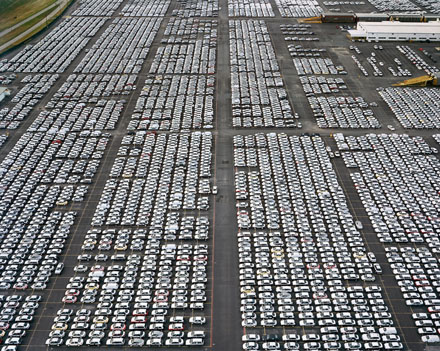The European tradition of landscape painting  created idealized representations of an arcadian world populated by shepherds and nymphs. The evenly distributed planes of sloping land in paintings by artists such as Poussin (one of whose works is featured to the right) created a balanced sense of landscape that reflected an idealized social order. These ordered representations of the land were given form in the ornate geometrical
created idealized representations of an arcadian world populated by shepherds and nymphs. The evenly distributed planes of sloping land in paintings by artists such as Poussin (one of whose works is featured to the right) created a balanced sense of landscape that reflected an idealized social order. These ordered representations of the land were given form in the ornate geometrical  symmetries of Renaissance Italian and French gardens such as those of Versailles, and, later, in the carefully constructed simulacrum of nature found in the gardens of English country houses.
symmetries of Renaissance Italian and French gardens such as those of Versailles, and, later, in the carefully constructed simulacrum of nature found in the gardens of English country houses.
Ironically, Poussin and other landscape artists such as Claude Lorrain created their works shortly before the onset of capitalism broke apart the stable feudal order that tied workers to the land, setting off a series of enclosures that radically dispossessed peasant communities across Europe. Similarly, the apparent self-enclosed order of the English garden was often a product of the brutal landscapes of exploitation that characterized slavery-driven sugar plantations in the Caribbean.
Each age, it seems, creates images of the landscape that just as often obscure the underlying social relations that produce nature as they idealize those social relations and the configuration of land produced by them.
What representations of landscape is our epoch creating?
It should not be much of a surprise that some of the most interesting depictions of contemporary landscapes depict a land blasted by industrialization and extreme extraction of various sorts. Edward Burtynsky’s series on Oil is typical in this regard. Burtynsky traces the various stages in the life of oil, from extraction (featured at the right) to the auto plants, flyovers, and fast food joints of Detroit and Los Angeles, to the toxic shipbreaking yards of Bangladesh.
His work is important since oil is such a contradictory substance. It is the lifeblood of US late capitalist culture, and yet is remains thoroughly invisible to most Americans. They see neither its  sites of extraction or refinement, and seldom think about the ways in which oil fuels virtually every aspect of life in the US, often at a serious toll of resources and blood for people in other parts of the world.
sites of extraction or refinement, and seldom think about the ways in which oil fuels virtually every aspect of life in the US, often at a serious toll of resources and blood for people in other parts of the world.
Other artist-activists have produced work which seeks to make this environmental toll visible. The Nigerian photographer George Osodi, for example, documents the massive environmental and social destruction caused in the Niger delta region of his country in a series of photographs reproduced in a montage here:
[youtube=http://www.youtube.com/watch?v=UzZCifz-XCA]
Nor are established forms of extraction such as petroleum the only form of manufacturing toxic industrial landscapes. The short photomontage Oil on Lubicon Land by Melina Laboucan-Massimo, a member of the Lubicon Cree First Nation and a Climate and Energy Campaigner with Greenpeace, describes the impact of oil and gas developments and the recent oil spill in the traditional territory of the Lubicon Cree in northern Alberta:
[youtube=http://www.youtube.com/watch?v=qz3nSscXamI]
There are many other artists working today on Manufactured Landscapes. Indeed, this geographical awareness, and the critical, investigative spirit that animates such depictions, could be said to be one of the most important trends in contemporary artwork. A key institution in supporting such work is the Center of Land Use Interpretation, whose website features photomontages every bit as devastating as those I’ve featured in this post.